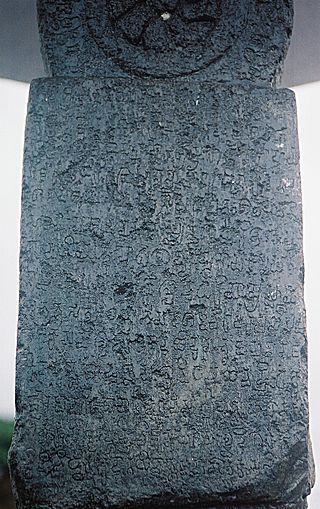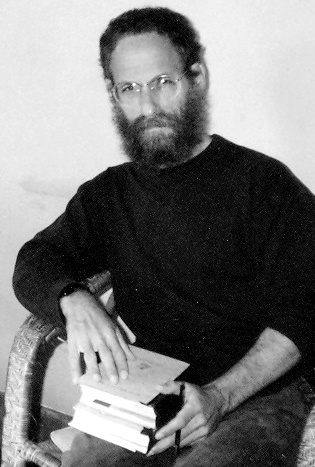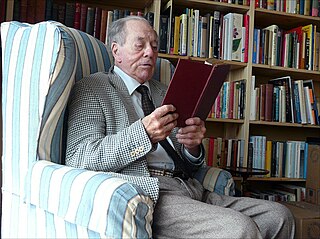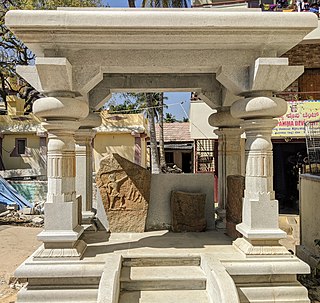Related Research Articles

Kannada, previously also known as Canarese, is a Dravidian language spoken predominantly by the people of Karnataka in southwestern India, with minorities in all neighbouring states. It has around 44 million native speakers, and is additionally a second or third language for around 15 million non-native speakers in Karnataka.
Khwārezmian is an extinct East Iranian language closely related to Sogdian. The language was spoken in the area of Khwarezm (Chorasmia), centered in the lower Amu Darya south of the Aral Sea.

The Halmidi inscription is the oldest known Kannada-language inscription in the Kadamba script. While estimates vary slightly, the inscription is often dated to between 450 CE - 500 CE. The inscription was discovered in 1936 by Dr. M. H. Krishna, the Director of Archaeology of the (princely) State of Mysore, in Halmidi, a village in the Hassan district.
Ernest Julius Walter Simon, was a German sinologist and librarian. He was born in Berlin and lived there, being educated at the University of Berlin, until he fled the Nazis to London in 1934, where he spent all the rest of his life except for brief periods as a visiting professor in various countries, teaching Chinese at the School of Oriental and African Studies, University of London from 1947 to 1960. He made great contributions to historical Chinese phonology and Sino-Tibetan linguistics. As a sinologist, he had a Chinese name, Ximen Huade.

Kappe Arabhatta was a Chalukya warrior of the 8th century who is known from a Kannada verse inscription, dated to c. 700 CE, and carved on a cliff overlooking the northeast end of the artificial lake in Badami, Karnataka, India. The inscription consists of five stanzas written out in ten lines in the Kannada script. Stanza 2 consists of a Sanskrit śloka. Of the remaining stanzas, all except the first are in the tripadi, a Kannada verse metre.

Alexander (Sasha) Vladimirovich Vovin was a Soviet-born Russian-American linguist and philologist, and director of studies at the School for Advanced Studies in the Social Sciences (EHESS) in Paris, France. He was a world-renowned linguist, well known for his research on East Asian languages.

Sheldon I. Pollock is an American scholar of Sanskrit, the intellectual and literary history of India, and comparative intellectual history. He is the Arvind Raghunathan Professor of South Asian Studies at Columbia University. He was the general editor of the Clay Sanskrit Library and the founding editor of the Murty Classical Library of India.
Alfred Felix Landon Beeston, FBA was an English Orientalist best known for his studies of Arabic language and literature, and of ancient Yemeni inscriptions, as well as the history of pre-Islamic Arabia. His works were generally published under the name A. F. L. Beeston.
Roland Grubb Kent was an American educator and a founder of the Linguistic Society of America (LSA). He was the first person to translate Marcus Terentius Varro's De Lingua Latina into English.
Charles Roskelly Bawden, FBA was a professor of the Mongolian language in the School of Oriental and African Studies (SOAS) at the University of London from 1970 to 1984.
Extinct Kannada literature is a body of literature of the Kannada language dating from the period preceding the first extant work, Kavirajamarga.
Tripadi is a native metre in the Kannada language dating back to c. 700 CE.
G. S. Gai was an Indian epigraphist, historical linguist, and historian, known for his expertise in early-medieval Kannada language inscriptions. From 1962 until 1976, Gai was the Chief Epigraphist for the Archaeological Survey of India.

Mysore Hiriyanna (1871–1950) was an eminent Indian philosopher, Sanskrit scholar and authority on Indian aesthetics. He was a Professor of Sanskrit at the University of Mysore and a contemporary of Sarvepalli Radhakrishnan. His classes on Indian Philosophy were comprehensive. His classroom dictations, published by Allen & Unwin in book form as "Outlines of Indian Philosophy" brought Hiriyanna international recognition. This was a seminal work on Indian Philosophy. His other prominent works include "Indian Conception of Values", "Essentials of Indian Philosophy", "The Quest after Perfection" and "Art Experience". He wrote extensively on the Vedic age, mainly on the Upanishads, followed by the evolution of Indian philosophical thought in the post-vedic era, deliberating mainly on Bhagavad Gita, the early years of Buddhism and Jainism. His work on aesthetics was authoritative and dealt mainly with Alamkaras, Aesthetics and Ethics, Method of Art, Indian Aesthetic Values and Art & Morality.

David Llewellyn Snellgrove, FBA was a British Tibetologist noted for his pioneering work on Buddhism in Tibet as well as his many travelogues.

John Faithfull Fleet C.I.E was an English civil servant with the Indian Civil Service and became known as a historian, epigraphist and linguist. His research in Indian epigraphy and history, conducted in India over a thirty-year period, is published in books including Pali, Sanskrit and Old Canarese Inscriptions, The Dynasties of the Kanarese Districts of The Bombay Presidency from the earliest historical times to the Musalman Conquest, and The Inscriptions of The Early Gupta Kings and their Successors. He was a regular contributor to works journals covering Indian history. His published well-regarded works on inscriptions in the Sanskrit, Pali and Kannada languages and on the history of dynasties such as the Guptas, Kadambas, Aulikaras, Chalukyas, Rashtrakutas and Seunas.

Mysore Hatti Krishna Iyengar was an Indian historian, archaeologist, epigraphist and authority in Indian numismatics. He pioneered the new field of Indology involving the study of Indian culture, history, music and traditions from a historical perspective. He is credited with the discovery of one of the oldest Kannada inscriptions, the Halmidi inscription, dating back to 350 A. D. He also discovered the remains of the city of Isila near Brahmagiri during his excavations at Chandravalli, Chitradurga. The forgotten tomb of Shahaji was traced by M. H. Krishna during his years at the Mysore Archaeological Department. His years at the Archaeology Department saw him churn out many of excavation reports and these were later published in successive volumes of Epigraphia Carnatica. During Krishna's tenure at Bangalore, he was instrumental in cataloguing close to 6000 coins in the archives of the archaeology department there. He was trained at the University College, London under Ernest Arthur Gardner. and would later accompany Sir Flinders Petrie in his excavations in Egypt.

Doddabele Lakshmi Narasimhachar was a Kannada linguist, grammarian, lexicographer, writer, literary critic and editor who taught at the Department of Kannada Language Studies, University of Mysore between 1932 - 1962. His knowledge of Halegannada helped him in reading ancient epigraphic records. He authored four books in Kannada, edited about nine volumes, penned eleven prefaces, wrote nearly hundred articles across three decades, seven monographs in English and outlined introductions to four Kannada works. He presided over the forty first Kannada Sahitya Sammelan held at Bidar in 1960. He was the recipient of the Kannada Rajyotsava Award from the Mysore State. In 1969, his alma mater - University of Mysore bestowed on him an Honorary Doctorate in recognition of a lifetime contribution to the world of Kannada studies.


Taľaku Subbanna Venkannayya was University of Mysore's first Kannada Professor. He was also a popular Kannada writer, translator, editor and teacher who nurtured many later Kannada littérateurs like Kuvempu, D. L. Narasimhachar, T. N. Srikantaiah, K. S. Narasimhaswamy, M. V. Seetharamaiah, C. K. Venkataramaiah, K. Venkataramappa, G. Venkatasubbiah and S. V. Parameshwara Bhatta. In fact, Kuvempu begins his book Sri Ramayana Darshanam with a two-page dedication to his teacher T. S. Venkannayya. T. S. Venkannayya translated the biography of Ramakrishna Paramahamsa from Bengali into Kannada for the first time in 1919. T. S. Venkannayya along with D. V. Gundappa, V. Seetharamaiah, B. M. Srikantaiah and T. N. Srikantaiah were at the forefront of the Kannada Movement from 1920s onwards and were instrumental in the founding of Kannada Sahitya Parishat (Bangalore) and Kannada Sangha at Central College, Bangalore and Maharaja College, Mysore. T. S. Venkannayya was responsible for the organising of the 1931 Kannada Sahitya Sammelan at Mysore.
References
- Narasimhia, A. N. (1936), "The History of 'p' in Kanarese", Bulletin of the School of Oriental Studies, University of London, Cambridge University Press, 8 (2/3): 673–680, doi:10.1017/S0041977X00141308, JSTOR 608075
- Narasimhia, A. N. (1941), A Grammar of the Oldest Kanarese Inscriptions (including a study of the Sanskrit and Prakrit loan words, Originally published: Mysore: University of Mysore. Pp. 375. Reprinted in 2007: Read Books. Pp. 416, ISBN 1-4067-6568-6